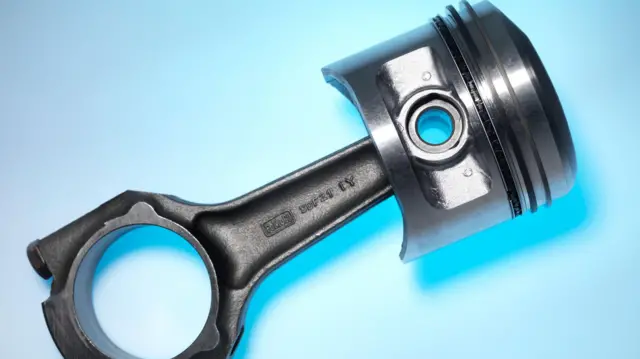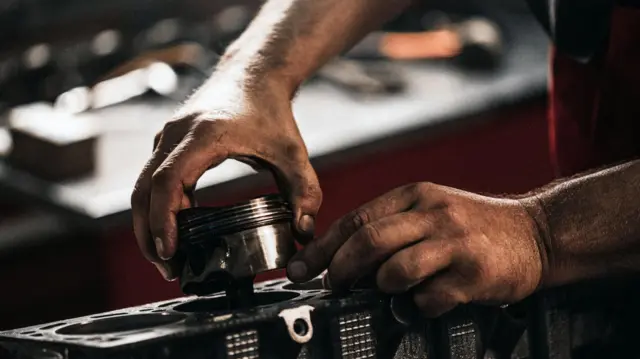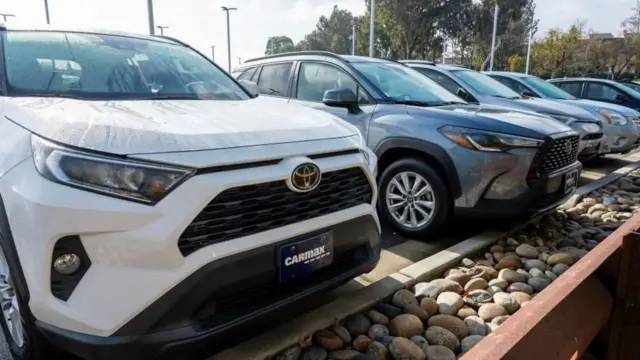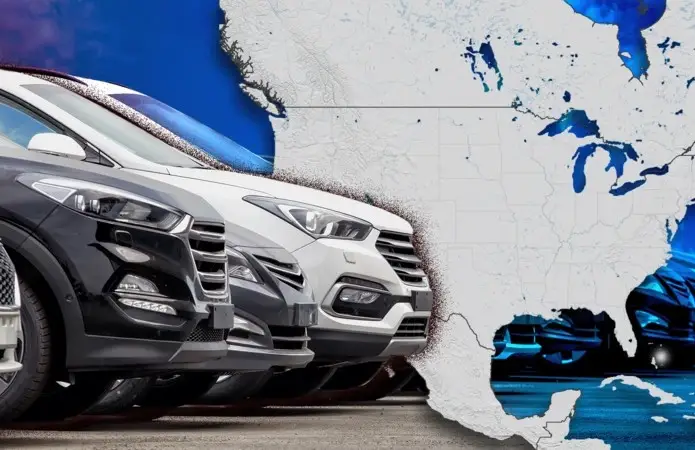US President Donald Trump announced this Wednesday “reciprocal tariffs” against dozens of countries amounting to a minimum of 10% in a speech from the White House.
Mexico and Canada, its neighbors and trading partners, were spared—for now—from paying these duties after the US government did not include them on the list.
However, the automotive industry will have to abide by the tariffs Trump had previously announced for that sector.
These automotive tariffs stipulate that a car from Mexico or Canada must pay a 25% tariff on its non-US content.
In the specific case of auto parts, a multi-million dollar industry in North America, the tariff would not take effect until May 3.
At BBC Mundo, we explain how the process of manufacturing a car works in the North American free trade zone.
A car has more than 30,000 parts. Some of these components cross the borders between Mexico, Canada, and the United States several times before entering the final product assembly.
The production chains between the three countries are so intertwined that the region’s automotive market has depended on trade integration between those nations for more than 30 years, since a free trade zone was created in 1992 through the NAFTA agreement, which later became the current USMCA.
For almost that entire time, North American automakers paid no tariffs. But that is about to change now that the White House has announced it will impose tariffs of up to 25% on all cars not manufactured in the United States.
In practice, this means that American importers of cars—and their components—will have to pay the tariff at customs every time they import a foreign vehicle.
Trump has said the measure will generate “tremendous growth” for his country’s auto industry, boosting jobs and investment within its borders.
“This is permanent,” Trump said a few days ago. “But if you make your cars in the U.S., there are no tariffs.”
Analysts have pointed out that the measure is likely to cause significant disruptions in manufacturing chains, raise prices for consumers, and strain relations with U.S. allies.
This trade shock will be felt both inside and outside the U.S.
Why is car production so complex?

Production is complex, primarily due to the high level of industrial integration in the vehicle manufacturing process, and the best way to understand this is through an example, such as the one shown in the following map.
The illustration follows the journey of an auto part from the purchase of the basic material for its manufacture until the final assembly.
In this case, it’s an aluminum piston, one of the most important mechanical parts in an engine.
Like many other auto parts, the piston travels several times between the three countries before reaching the final consumer.
Infographic showing how auto parts move between Canada, Mexico, and the United States
A car uses several pistons, and their main function is to generate the energy that drives the vehicle’s movement. Here’s an explanation of each of the points shown on the map:
Point 1: Aluminum powder shipped from Tennessee
On this map, the piston’s journey begins with aluminum powder, a lightweight metal with high thermal conductivity and easy cutting. The aluminum is transformed into a metal bar from which the piston will be manufactured.
Step 2: Pistons are made in Pennsylvania
In Pennsylvania, the metal is cast or forged, depending on the piston’s manufacturing method. Alloys of aluminum and other metals are often used.
Step 3: Connecting rods are molded and polished in Canada
The piston manufactured in Pennsylvania crosses the border to arrive in Canada, where an essential part of the mechanism, called the connecting rod, is molded and polished.
Step 4: The connecting rods are sent to Mexico for assembly.
The piston and connecting rod are assembled in Mexico. These parts are joined by the crankshaft, an axis that transforms rectilinear motion into circular motion and vice versa, so that it reaches the car’s wheels.
Step 5: The pistons enter the engine in Michigan
In Michigan City, in the United States, the piston is finally placed inside the engine, as shown in the illustration.

In this example, the piston only crosses North American borders three times: first, it travels from the U.S. to Canada, then from Canada to Mexico, and from Mexico back to the U.S.
However, there are other examples that involve more border crossings, depending on the raw material used for the auto part, the number of companies involved in the industrial chain, where the entire vehicle is assembled, and the country in which the product’s final destination is located.
This explains why a piston can use a different route than the one shown in the illustration and, in some cases, cross borders up to six times.
This is the case with pistons that use aluminum shipped from Michigan to Ontario (crossing the U.S.-Canada border).
In Ontario, the aluminum is melted and processed, returns to Michigan, and from there travels to Mexico for finishing.
From Mexico, it is shipped to Wisconsin, where it is assembled into connecting rods and rings, then travels to an engine plant in Michigan and from there returns to a plant in Ontario.
Finally, the finished vehicle is shipped from Canada to the U.S. or Mexico, where it will be sold.
This complex back-and-forth of a part is part of a well-oiled commercial system that has a long history and on which many small companies depend, providing other services and components during the process.
This is the case with a car’s transmission modules, which can cross borders up to seven times, or a seatbelt manufactured in Mexico, which can cross North America up to nine times.
Thus, with all the auto parts a vehicle carries inside, tariffs have become a headache for companies located in the three countries involved in the production chain.
What effects could tariffs have on the automotive industry?
The tariffs imposed on the automotive sector are in addition to the 25% tariffs the Trump administration imposed on steel and aluminum in March, amplifying the impact of U.S. tariff policy on its trading partners.
Despite the negative reaction the White House’s strategy has generated among its neighbors, the measure includes some exceptions for automotive products from those two countries, such as the provision that deducts the vehicle’s “U.S. content” from the tariff rate.
Under this exception, cars from those two nations would only have to pay the 25% tariff on their non-U.S. content.
This is determined through a certification process that establishes the origin of the components that make up the final product.

Therefore, the impact of the tariffs will vary depending on each make and model of car that crosses the border, as not all have the same percentages of foreign and U.S. content.
Some analysts have estimated that cars imported from Mexico may end up paying an average tariff rate of around 15%, but other experts believe it is still too early to determine what the final percentage will actually be.
These conditions will apply to complete cars imported into the U.S. However, Mexican auto parts have a longer period of time to adjust to the new taxes.
This is because the White House has given a one-month respite to automotive components while it defines a methodology for certifying their origin.
Whatever the final tariff a car importer pays, experts have warned that the cars will go up in price. And Donald Trump himself has said that if the price goes up, “he couldn’t care less.”
In the US, economists warn that rising vehicle prices could increase inflation, especially when the tariff on the auto industry goes hand in hand with tariffs imposed on other products.
The combined tariff measures will be difficult to keep inflation under control, they argue.
Rising car prices, experts explain, could reduce consumer demand and affect the country’s economic growth, eventually leading to a potential recession.
Economic growth could also be affected in Mexico and Canada, although on the Mexican side, the situation is even more critical given the magnitude of the automotive industry and the significant weight of its exports in the national economy.
Mexican President Claudia Sheinbaum has expressed concern about the job losses that the measure could generate. Even many small factories could go bankrupt if they fail to withstand the impact.
In Mexico, too, there is concern that the White House’s tariff policy could reduce investment, increase unemployment, and affect the entire economy.
Car Prices
Mexico is the leading exporter of automobiles to the US, followed by South Korea, Japan, Canada, and Germany.
In 2024, the Latin American country shipped nearly 3 million finished vehicles, valued at nearly US$78.5 billion.
When auto parts and engines are added, total shipments exceed US$182 billion, according to figures from the US Department of Commerce.
Due to the deep regional integration of the automotive industry in North America, analysts predict that car prices will rise.

Source: bbc




